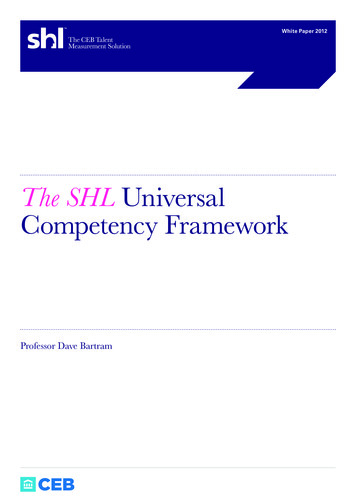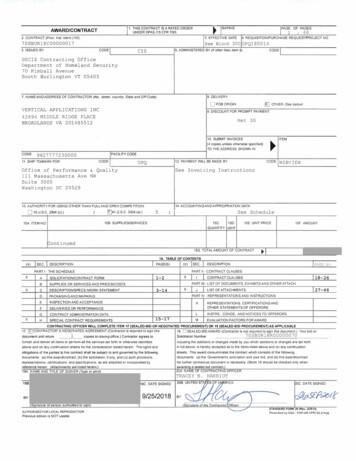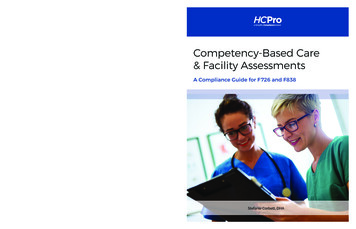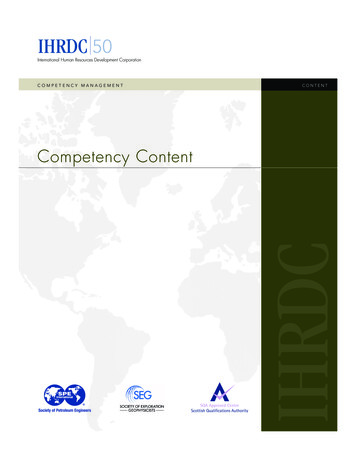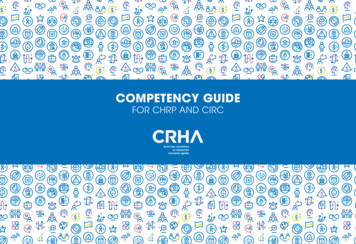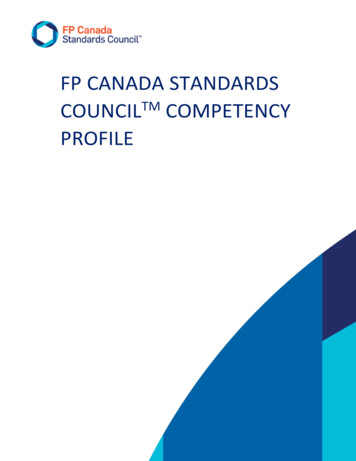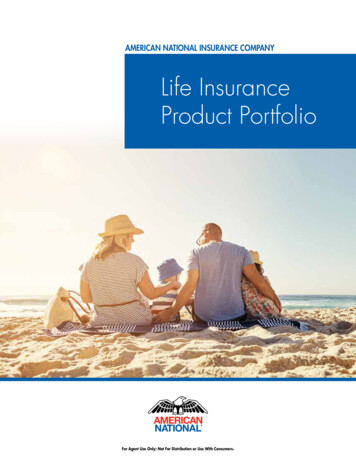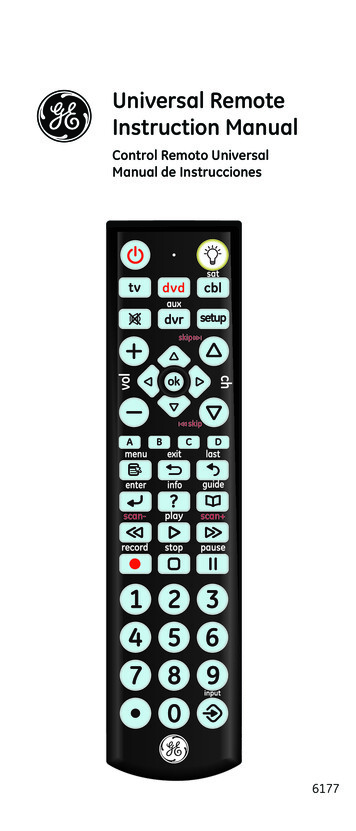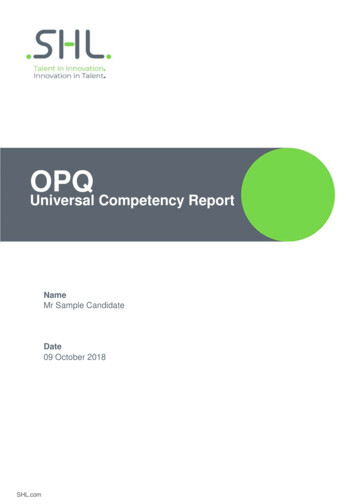
Transcription
OPQUniversal Competency ReportNameMr Sample CandidateDate09 October 2018SHL.com
INTRODUCTIONThis report is intended for use by managers and HR professionals. It summarises how Mr.Candidate's preferred style or typical way of behaving is likely to influence his potentialperformance on twenty universal competencies. This potential is based on Mr. Candidate'sresponses to the Occupational Personality Questionnaire (OPQ). His responses have beencompared against those of a large relevant comparison group to give a description of Mr.Candidate's preferred approach to work.The responses Mr. Candidate gave show the way he sees his own behaviour, rather than howanother person might describe him. This report describes preferred ways of behaving, ratherthan actual skills levels. The accuracy of this report depends on the frankness with which heanswered the questions as well as his self-awareness. Nevertheless, this report providesimportant indicators of Mr. Candidate's style at work. This report links the information fromthe personality questionnaire to the twenty universal competencies.This report has a shelf-life of 18-24 months and should be treated confidentially. If there aremajor changes in his life or work he should complete the OPQ again.If you require support in interpreting this report, please contact a person in your organisationwho has received full training in the use of the OPQ.When using this report it is important to consider which of the twenty universal competenciesmeasured are most relevant to successful performance in the job that is being considered.REPORT KEYThe ticks, crosses and discs indicate which aspects of Mr. Candidate's style are likely tocontribute positively or more negatively to each competency.Symbol 09 October 2018Short DescriptionKey StrengthLikely StrengthModerateLikely LimitationKey LimitationDefinitionVery likely to have a positive impactLikely to have a positive impactLikely to have neither a positive nor a negative impactLikely to have a negative impactVery likely to have a negative impactUniversal Competency ReportMr Sample Candidate 2018 SHL and/or its affiliates. All rights reserved.2 of 11
The overall likelihood of Mr. Candidate displaying strength in each competency is shown in thebar graphs on the right hand side of the report.123Unlikely to be Less likely to be Moderatelya strengtha strengthlikely to be astrength09 October 201845Quite likely to be Very likely to be aa strengthstrengthUniversal Competency ReportMr Sample Candidate 2018 SHL and/or its affiliates. All rights reserved.3 of 11
SUMMARY OF COMPETENCY POTENTIALThe table below provides a summary of Mr. Candidate's potential performance on the twentycompetencies. By selecting those competencies that are most important for the role, andprobing those areas for evidence of how Mr. Candidate has demonstrated effectiveness, youare more likely to recruit the best person for the job.Definitions of the twenty competencies can be found towards the back of this report.Recommended interview questions for each of the competencies are provided in the UniversalCompetency Framework Interview Guide. Competency profiling cards are also available tohelp in identifying essential or desirable competencies. Please note that the Interview Guideand Competency Profiling Cards are available in a limited range of languages. For moreinformation contact your SHL representative.1Competency2345Important forSuccess? (tick)Leading and Deciding1.1 Deciding and Initiating Action1.2 Leading and SupervisingSupporting and Co-operating2.1 Working with People2.2 Adhering to Principles and Values1Interacting and Presenting3.1 Relating and Networking3.2 Persuading and Influencing3.3 Presenting and Communicating InformationNVAnalysing and Interpreting4.1 Writing and ReportingV4.2 Applying Expertise and Technology4.3 AnalysingDNVDNVCreating and Conceptualising5.1 Learning and Researching5.2 Creating and InnovatingDNVDNV5.3 Formulating Strategies and ConceptsDNVOrganising and Executing6.1 Planning and Organising6.2 Delivering Results and Meeting Customer Expectations6.3 Following Instructions and ProceduresDNVAdapting and Coping7.1 Adapting and Responding to Change7.2 Coping with Pressures and SetbacksEnterprising and Performing8.1 Achieving Personal Work Goals and Objectives8.2 Entrepreneurial and Commercial ThinkingNThe index numbers refer to the 20 competency dimensions from the SHL Universal Competency Framework TM.1OPQ32 only assesses some aspects of this competency, specifically related to the areas of rule-following and utilising diversity.DNVCompetencies with these symbols were calculated with contributions from ability tests. The symbols indicate which tests wereincluded. D: diagrammatic/inductive N: numerical. V: verbal.09 October 2018Universal Competency ReportMr Sample Candidate 2018 SHL and/or its affiliates. All rights reserved.4 of 11
COMPETENCY POTENTIAL PROFILE1. Leading and Deciding12345123451.1 Deciding and Initiating Action Holds strong views and is comfortable with acting independently. Places a moderate emphasis on achieving difficult targets. Has an extreme dislike of taking charge of situations. Is likely to be cautious and very slow when making decisions.1.2 Leading and Supervising Is extremely likely to feel uncomfortable leading a group. Is highly unlikely to use persuasion when motivating others. Very rarely seeks to understand what motivates others. Is very unlikely to trust, and thus empower, others.2. Supporting and Co-operating2.1 Working with People Is extremely likely to enjoy spending time with other people. Is as prepared and as comfortable as most others to seek contributions from others in order to make adecision. Drive to be moderately competitive may affect co-operation with colleagues. Is likely to be very selective with support and sympathy. Very rarely seeks to understand the reasons for others' behaviour.2.2 Adhering to Principles and Values 1Is extremely likely to follow rules and regulations.Is as likely as others to seek a diverse range of views.3. Interacting and Presenting123453.1 Relating and Networking May not consistently feel confident in formal business situations. Tends to be quiet and reserved in groups. Is very unlikely to adapt personal style to fit in with others. Very unlikely to attempt to understand what motivates others.3.2 Persuading and Influencing May not consistently feel confident when influencing others, especially strangers. Tends to be reserved when in group situations. Strongly dislikes selling and negotiating. May very rarely seek to understand other peoples' needs and motives. Is extremely unlikely to promote own credentials.3.3 Presenting and Communicating Information 1NVMay not consistently feel confident when formally presenting. May nearly always feel tense before important occasions. Is very unlikely to adapt his own style and approach to the audience. Strongly dislikes using persuasion when putting forward an argument.OPQ32 only assesses some aspects of this competency, specifically related to the areas of rule-following and utilising diversity.NVCompetencies with these symbols were calculated with contributions from ability tests. The symbols indicate which tests wereincluded. N: numerical. V: verbal.09 October 2018Universal Competency ReportMr Sample Candidate 2018 SHL and/or its affiliates. All rights reserved.5 of 11
4. Analysing and Interpreting4.1 Writing and Reporting234512345V May evaluate the content of written information critically. Is likely to produce documents that are quite structured. Is as likely as most others to see the relevance of abstract concepts in written work. May very rarely seek to understand the needs of an audience.4.2 Applying Expertise and TechnologyDNV May look critically at technical information. Will be as comfortable as most with theory and abstract concepts. Is as comfortable as most when working with numerical data.4.3 Analysing1DNV May look critically at information for potential errors in analysis. Is as likely as most to enjoy dealing with abstract concepts. Is as comfortable as most others when analysing numerical information.5. Creating and Conceptualising5.1 Learning and ResearchingDNV May look critically for potential limitations when reviewing new information. Is moderately interested in learning about abstract concepts. Is likely to be moderately comfortable when required to work with numerical data. Is very likely to follow conventional approaches when learning new tasks.5.2 Creating and InnovatingDNV Very much enjoys constant variety and change. Sees some relevance in applying theories to problem solving. Tends not to see himself as a creative individual. Is very likely to favour traditional methods.5.3 Formulating Strategies and ConceptsDNV May take a long term perspective when developing strategy. Is as likely as most to see the relevance of thinking conceptually when developing strategy. May sometimes become preoccupied by details. Is very likely to follow traditional approaches when establishing the vision.DNVCompetencies with these symbols were calculated with contributions from ability tests. The symbols indicate which tests wereincluded. D: diagrammatic/inductive N: numerical. V: verbal.09 October 2018Universal Competency ReportMr Sample Candidate 2018 SHL and/or its affiliates. All rights reserved.6 of 11
6. Organising and Executing1234512345123456.1 Planning and Organising Takes a strategic perspective when planning. Pays some attention to detail when planning. Recognises the need to complete plans to deadline. Has an extreme dislike of managing others.6.2 Delivering Results and Meeting Customer Expectations Is extremely likely to adhere to rules, regulations and set procedures. Quite likely to adopt a methodical and organised approach. Recognises the need to complete tasks in line with expectations. Is as likely as most to set stretching goals for himself and others.6.3 Following Instructions and ProceduresDNV Is extremely likely to follow rules and procedures. Tends to recognise the need to keep to agreed schedules. May hold strong views and challenge instructions from others.7. Adapting and Coping7.1 Adapting and Responding to Change Tends to very much enjoy new experiences. Is unlikely to adapt an interpersonal style across situations. Is very likely to prefer well-established work methods. Very rarely seeks to understand differences in motives and behaviours of others.7.2 Coping with Pressures and Setbacks Maintains an outlook that balances positives and negatives. May experience a little difficulty in switching off from work pressures. Tends to be fairly open in expressing emotions. May be sensitive to criticism or negative feedback.Spacer8. Enterprising and Performing8.1 Achieving Personal Work Goals and Objectives Likely to take a strategic approach to his own development. Is likely to be comfortable with a very demanding schedule. Is likely to be comfortable in competitive situations. Is as motivated as most others to progress his career.8.2 Entrepreneurial and Commercial ThinkingN Is quite likely to excel in the competitive environment of commercial situations. May be motivated to some extent by stretching financial targets. Is as comfortable as most working with financial information.DNVCompetencies with these symbols were calculated with contributions from ability tests. The symbols indicate which tests wereincluded. D: diagrammatic/inductive N: numerical. V: verbal.09 October 2018Universal Competency ReportMr Sample Candidate 2018 SHL and/or its affiliates. All rights reserved.7 of 11
COMPETENCY DEFINITIONS1. Leading and Deciding1.1 Deciding and Initiating ActionTakes responsibility for actions, projects and people; takes initiativeand works under own direction; initiates and generates activity andintroduces changes into work processes; makes quick, clear decisionswhich may include tough choices or considered risks.1.2 Leading and SupervisingProvides others with a clear direction; motivates and empowersothers; recruits staff of a high calibre; provides staff withdevelopment opportunities and coaching; sets appropriate standardsof behaviour.2. Supporting and Co-operating2.1 Working with PeopleShows respect for the views and contributions of other teammembers; shows empathy; listens, supports and cares for others;consults others and shares information and expertise with them;builds team spirit and reconciles conflict; adapts to the team and fitsin well.2.2 Adhering to Principles and ValuesUpholds ethics and values; demonstrates integrity; promotes anddefends equal opportunities, builds diverse teams; encouragesorganisational and individual responsibility towards the communityand the environment.3. Interacting and Presenting3.1 Relating and NetworkingEasily establishes good relationships with customers and staff; relateswell to people at all levels; builds wide and effective networks ofcontacts; uses humour appropriately to bring warmth to relationshipswith others.3.2 Persuading and InfluencingGains clear agreement and commitment from others by persuading,convincing and negotiating; makes effective use of political processesto influence and persuade others; promotes ideas on behalf of oneselfor others; makes a strong personal impact on others; takes care tomanage one’s impression on others.3.3 Presenting and Communicating InformationSpeaks fluently; expresses opinions, information and key points of anargument clearly; makes presentations and undertakes publicspeaking with skill and confidence; responds quickly to the needs ofan audience and to their reactions and feedback; projects credibility.4. Analysing and Interpreting4.1 Writing and ReportingWrites convincingly; writes clearly, succinctly and correctly; avoidsthe unnecessary use of jargon or complicated language; writes in awell-structured and logical way; structures information to meet theneeds and understanding of the intended audience.4.2 Applying Expertise and TechnologyApplies specialist and detailed technical expertise; uses technology toachieve work objectives; develops job knowledge and expertise(theoretical and practical) through continual professionaldevelopment; demonstrates an understanding of differentorganisational departments and functions.4.3 AnalysingAnalyses numerical data and all other sources of information, tobreak them into component parts, patterns and relationships; probesfor further information or greater understanding of a problem; makesrational judgements from the available information and analysis;demonstrates an understanding of how one issue may be a part of amuch larger system.09 October 2018Universal Competency ReportMr Sample Candidate 2018 SHL and/or its affiliates. All rights reserved.8 of 11
5. Creating and Conceptualising5.1 Learning and ResearchingRapidly learns new tasks and commits information to memory quickly;demonstrates an immediate understanding of newly presentedinformation; gathers comprehensive information to support decisionmaking; encourages an organisational learning approach (i.e. learnsfrom successes and failures and seeks staff and customer feedback).5.2 Creating and InnovatingProduces new ideas, approaches, or insights; creates innovativeproducts or designs; produces a range of solutions to problems.5.3 Formulating Strategies and ConceptsWorks strategically to realise organisational goals; sets and developsstrategies; identifies, develops positive and compelling visions of theorganisation’s future potential; takes account of a wide range of issuesacross, and related to, the organisation.6. Organising and Executing6.1 Planning and OrganisingSets clearly defined objectives; plans activities and projects well inadvance and takes account of possible changing circumstances;identifies and organises resources needed to accomplish tasks; managestime effectively; monitors performance against deadlines andmilestones.6.2 Delivering Results and Meeting CustomerExpectationsFocuses on customer needs and satisfaction; sets high standards forquality and quantity; monitors and maintains quality and productivity;works in a systematic, methodical and orderly way; consistentlyachieves project goals.6.3 Following Instructions and ProceduresAppropriately follows instructions from others without unnecessarilychallenging authority; follows procedures and policies; keeps toschedules; arrives punctually for work and meetings; demonstratescommitment to the organisation; complies with legal obligations andsafety requirements of the role.7. Adapting and Coping7.1 Adapting and Responding to ChangeAdapts to changing circumstances; tolerates ambiguity; accepts newideas and change initiatives; adapts interpersonal style to suit differentpeople or situations; shows an interest in new experiences.7.2 Coping with Pressures and SetbacksMaintains a positive outlook at work; works productively in a pressurisedenvironment; keeps emotions under control during difficult situations;handles criticism well and learns from it; balances the demands of awork life and a personal life.8. Enterprising and Performing8.1 Achieving Personal Work Goals andObjectivesAccepts and tackles demanding goals with enthusiasm; works hard andputs in longer hours when it is necessary; seeks progression to roles ofincreased responsibility and influence; identifies own development needsand makes use of developmental or training opportunities.8.2 Entrepreneurial and Commercial ThinkingKeeps up to date with competitor information and market trends;identifies business opportunities for the organisation; maintainsawareness of developments in the organisational structure and politics;demonstrates financial awareness; controls costs and thinks in terms ofprofit, loss and added value.09 October 2018Universal Competency ReportMr Sample Candidate 2018 SHL and/or its affiliates. All rights reserved.9 of 11
ABILITY TESTS AND COMPETENCIESThe relationship between UCF competencies and ability tests is shown in the table iveFor some competencies, a number of ability tests may be relevant. However, this does notmean that all of these ability tests need to be completed. The choice of ability tests should bedriven by an understanding of the job requirements (please consult with a qualified personwithin your organisation for further guidance if needed). Competency predictions are stillrobust if only OPQ or OPQ with one or two ability tests have been used. 1.1 Deciding and Initiating Action1.2 Leading and Supervising2.1 Working with People2.2 Adhering to Principles and Values3.1 Relating and Networking3.2 Persuading and Influencing3.3 Presenting and Communicating Information4.1 Writing and Reporting 4.2 Applying Expertise and Technology 4.3 Analysing 5.1 Learning and Researching 5.2 Creating and Innovating 5.3 Formulating Strategies and Concepts 6.1 Planning and Organising6.2 Delivering Results and Meeting Customer Expectations6.3 Following Instructions and Procedures7.1 Adapting and Responding to Change7.2 Coping with Pressures and Setbacks8.1 Achieving Personal Work Goals and Objectives8.2 Entrepreneurial and Commercial Thinking Key : The ability test is relevant to the competency, has been completed and is included in the assessment : The ability test is relevant to the competency but has not been completed and is not included in the assessment[Greyed out]: There are no ability tests relevant to this competency09 October 2018Universal Competency ReportMr Sample Candidate 2018 SHL and/or its affiliates. All rights reserved.10 of 11
ASSESSMENT METHODOLOGYThis Profile is based upon the following sources of information for Mr Sample Candidate:Questionnaire / Ability TestComparison GroupOPQ32r UK English v1 (Std Inst)OPQ32r UK English Public Sector 2012 (AUS)Graduate/University Verbal Reasoning RUSGeneral Population 2006Graduate/University Numerical Reasoning RUSGeneral Population 2006Graduate/University Inductive Reasoning RUSGeneral Population 2007PERSON DETAIL SECTIONNameMr Sample CandidateCandidate DataRP1 1, RP2 2, RP3 7, RP4 8, RP5 3, RP6 9, RP7 4, RP8 10, RP9 6, RP10 2, TS1 5,TS2 8, TS3 1, TS4 9, TS5 6, TS6 4, TS7 10, TS8 2, TS9 8, TS10 7, TS11 6, TS12 10,FE1 4, FE2 9, FE3 3, FE4 6, FE5 1, FE6 4, FE7 8, FE8 7, FE9 5, FE10 2, CNS 7.N Sten 3/7 %ile V Sten 1/1 %ile D Sten 2/3 %ileReportThe Universal Competency Report Version Number: 1.1 REABOUT THIS REPORTThis report was generated using SHL’s Online Assessment System. It includes informationfrom the Occupational Personality QuestionnaireTM (OPQ32). The use of this questionnaire islimited to those people who have received specialist training in its use and interpretation.The report herein is generated from the results of a questionnaire answered by therespondent(s) and substantially reflects the answers made by them. Due consideration mustbe given to the subjective nature of questionnaire-based ratings in the interpretation of thisdata.This report has been generated electronically - the user of the software can makeamendments and additions to the text of the report.SHL Global Management Limited and its associated companies cannot guarantee that thecontents of this report are the unchanged output of the computer system. We can accept noliability for the consequences of the use of this report and this includes liability of every kind(including negligence) for its contents.www.shl.com 2018 SHL and/or its affiliates. All rights reserved. SHL and OPQ are trademarks registeredin the United Kingdom and other countries.The SHL Universal Competency Framework, SHL Competency Profiler and SHL CompetencyDesigner are protected by copyright 2004 - 2018 SHL and/or its affiliates. All rightsreserved.This report has been produced by SHL for the benefit of its client and contains SHLintellectual property. As such, SHL permits its client to reproduce, distribute, amend andstore this report for its internal and non-commercial use only. All other rights of SHL arereserved.09 October 2018Universal Competency ReportMr Sample Candidate 2018 SHL and/or its affiliates. All rights reserved.11 of 11
Competency profiling cards are also available to help in identifying essential or desirable competencies. Please note that the Interview Guide . 1 OPQ32 only assesses some aspects of this competency, specifically related to the areas of rule-following and utilising diversity.

